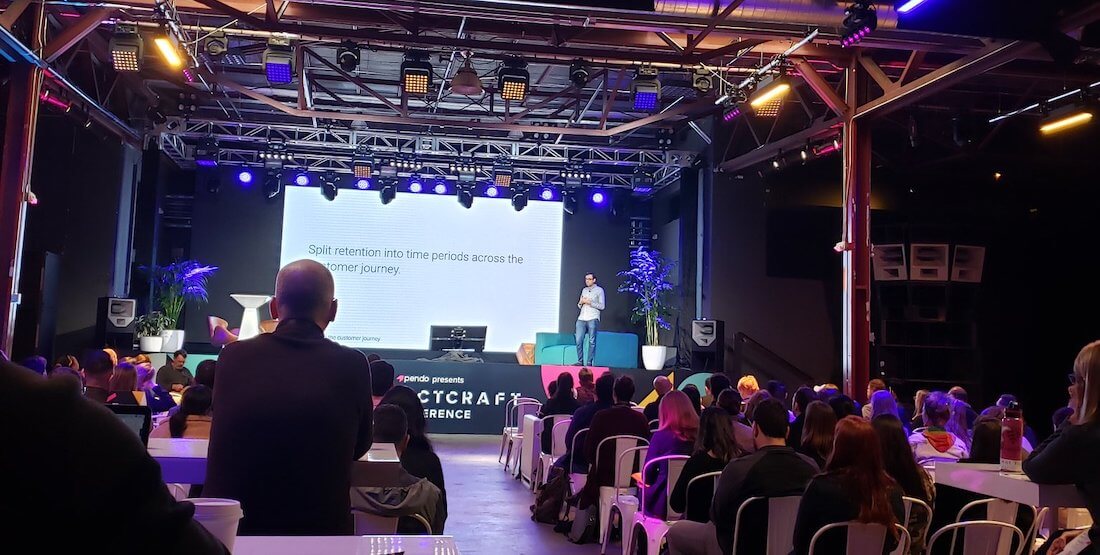“Who here cares about retention?”
Hiten Shah, serial entrepreneur and co-founder of FYI, kicked off his presentation at ProductCraft Conference: San Francisco with this question. To his relief, hands shot up around the crowded room. In his opinion, it made perfect sense that product managers would want to do their part to keep users coming back. But according to his own research, that wasn’t necessarily the case.

Recently, the FYI team conducted a deep-dive analysis of product manager job postings and came up with some interesting results. Some, like the finding that empathy is a key PM skill or that product managers should be data-driven, weren’t all that surprising. Others, however, were completely unexpected. The main shocker? That the word “retention” was absent from 100% of these job descriptions.
This is surprising, not just based on the results of Hiten’s impromptu poll, but because of the many benefits that strong retention can bring to your product.
Good retention = good everything
Having “good” retention means that users keep coming back. In the very best cases, they can’t live or work without your product. If your users interact with your product frequently and find value when doing so, they’re more likely to become advocates and promoters. Good retention leads to users who tell their coworkers and friends about your product, boosting word of mouth and driving new signups or purchases. Your product’s “regulars” are the ones who share and interact with your posts on social media, click on your emails, give you high ratings, and much more.
Who wouldn’t want that?
Getting to good retention
According to Hiten, “good retention is the result of customer obsession.” If you want to create a product team culture centered around the customer, you have to put customer needs above business needs and customer benefits over features. Once you’ve made a commitment to customer-first thinking, you’ll be far better positioned to retain users month-over-month and even year-over-year.
To grow that userbase of “regulars” who promote and engage with your product, Hiten recommends following these three steps.
No. 1: Start with the customer journey
The first is all about gathering information about how frequently your users are returning to your product. Retention can be broken up into three time periods: short-term (one week), mid-term (weeks 2-4), and long-term (weeks 5+). Each of these timeframes comes with its own set of retention-related questions. Over the short-term, for example, you might ask: Do users come back after their first visit? How frequently do they use the product during Week One?
Over the mid-term, your team should work to determine which problem new users are trying to solve. Is it a particularly “painful” problem? Do they deal with this problem frequently? And over the long-term, your goal is to have your product be a part of your users’ daily workflows.
No. 2: Work backward from the customer
This step is all about researching the customer, uncovering their needs/wants, and working backward from their feedback to craft your product experience. The “working backwards” idea comes from Ian McAllister of Amazon, who said, “We try to work backwards from the customer, rather than starting with an idea for a product and trying to bolt customers onto it.” In fact, the Amazon team starts their product build process by writing the press release.
How do you work backwards from the customer? You ask them about how they’re using your product. Again, Hiten called attention to short-term, mid-term, and long-term retention timeframes. During Week One, you might discover that some people sign up for your service, but never actually use it. Hiten suggested directly asking these users why they haven’t actually interacted with the product. His company, FYI, sends emails to those individuals asking for feedback.
Over the mid-term, ask your most active users what exactly is bringing them back into your product. What makes it a “habit?” And for your long-term users, Hiten recommended asking them what he called the “product-market fit question:” How disappointed would you feel if this product no longer existed?” The answers to this question in particular can give valuable insights into how you can build your product for continued success.
No. 3: Run small experiments
Hiten called out this step as the most important of the three. At this stage in your company’s journey toward strong retention through customer obsession, your team should embrace “step one thinking.” To make your customers happy and keep them coming back to your product, you don’t need to do everything at once. Instead, you can craft an ideal user experience brick-by-brick, adding and iterating over time.
Start with step one
When faced with a customer pain point or a specific product goal, the tendency of most product teams is to jump right into “build mode.” According to Hiten, this is a bad idea. Resist that urge, and remind your team to think about the very first step, rather than what a finished feature might look like.
Take baby steps
Hiten mentioned Instagram as an example of step-one thinking. To compete with Pinterest, they wanted to offer users the ability to create curated image collections. Rather than creating a “collections” feature and shipping it, they decided to test the waters before making such a big commitment. Their first step was to add a “save” button to every image — a relatively quick and straightforward update. They also allowed users to view all of their saved posts in one place.
Iterate fast
With the introduction of saved posts, Instagram was laying the foundation for full “curated collections” functionality. Soon thereafter, users could view all of their saved images in one place. And about six months after that, they gave users the ability to organize their saved posts by theme, essentially recreating Pinterest’s key feature. Now, Instagram Collections is a popular feature within the app.
Showing that you care
To sum up, Hiten reiterated that product managers should care about retention. To prove that to both your users and your internal team, PMs need to demonstrate a commitment to their customers and a focus on metrics like stickiness. And remember: you don’t have to do everything at once. Start with step one, build brick-by-brick, and before you know it, you’ll have a huge cohort of product regulars who can’t live without your product.


